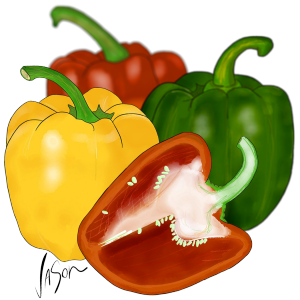by Jason Ford
Ford on Food
As an Australian, I personally don’t feel comfortable with “Capsicums” being referred to as “Peppers” – it’s un-Australian, by crikey!
However, it’s completely normal to call them bell peppers (or just peppers) in many other countries.
Christopher Columbus purposefully misnamed the small chilli variety as pepper so he could sell it as a cheap alternative to the expensive spice (peppercorns).
Nevertheless, if you read an American recipe book asking for bell peppers or a UK cookbook asking for red peppers. they are referring to capsicum.
The capsicum is actually a fruit, but it is generally used as a vegetable (though I once ate sweet capsicum sorbet).
The shapes vary considerably, from rounded like tomatoes, to long banana shapes or the more common box shapes..
There is also a rainbow of colours – green, yellow, orange, red, purple and almost black.
Most capsicum starts green and change to their various colours as they ripen.
Capsicums can be eaten fresh in salads; as crudités, stuffed and baked; in stir-fries; in soups (like Spanish gazpacho); cooked into a sweet conserve; or roasted.
* * *
Roast Capsicum
 Although this has been cooked in the Mediterranean area for centuries, it has become very popular in Western countries and is often used on antipasto platters, in salads or on pizzas.
Although this has been cooked in the Mediterranean area for centuries, it has become very popular in Western countries and is often used on antipasto platters, in salads or on pizzas.
I love it, because the roasting method sweetens the flesh and provides a smoky aroma.
- Smear a capsicum (usually red) with Extra Virgin Olive Oil.
- Place in a hot oven at 210 degrees for 20-30 minutes.
- Turn the capsicum occasionally to get even blistering of the outer skin.
- Immediately on removal from the oven, wrap the capsicum in glad wrap, which sweats off the skin.
- When cool, peel off and discard the skin – do not wash the flesh under water or you will loose precious flavour.
- Stores in the fridge for up to a week.
A similar effect can be achieved on the grill bars of a barbeque, which will produce a smoky flavoured flesh.
























